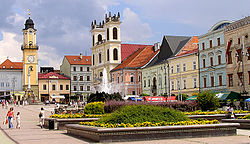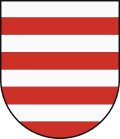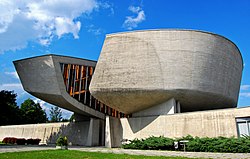Banská Bystrica
Banská Bystrica (German: Neusohl, Hungarian: Besztercebánya, Latin: Villa Nova), is a large town in central Slovakia, on the Hron river.
City | |
 | |
| Etymology: "mining creek" | |
| Coordinates: 48°44′07″N 19°08′43″E / 48.73528°N 19.14528°ECoordinates: 48°44′07″N 19°08′43″E / 48.73528°N 19.14528°E | |
| Country | |
| Region | Banská Bystrica |
| District | Banská Bystrica |
| First mentioned | 1255 |
| Government | |
| • Mayor | Ján Nosko |
| Area | |
| • Total | Lua error in Module:SK at line 14: attempt to index field 'wikibase' (a nil value). km2 (Formatting error: invalid input when rounding sq mi) |
| (2022) | |
| Elevation | 362 m (1,188 ft) |
| Population | |
| • Total | Lua error in Module:SK at line 14: attempt to index field 'wikibase' (a nil value). |
| Time zone | UTC+1 (CET) |
| • Summer (DST) | UTC+2 (CEST) |
| Postal code | 97401 |
| Car plate | BB |
| Website | eng.banskabystrica.sk |
History
It was first mentioned in 1255 as a royal free mining town. The town had rich ore deposits, mainly copper, and to a lesser extent silver, gold and iron. As the deposits were depleted, the town has reoriented to the industry. During the World War II, the Slovak National Uprising broke out in the town.
Population
| Year: |
|---|
| Count: |
| Progress: |
| Year: |
|---|
| Count: |
| Progress: |
Sister cities
 - Durham, England
- Durham, England - Hradec Králové, Czech Republic
- Hradec Králové, Czech Republic - Salgótarján, Hungary
- Salgótarján, Hungary - Tula, Russia
- Tula, Russia - Herzliya, Israel
- Herzliya, Israel - Larissa, Greece
- Larissa, Greece - Montana, Bulgaria
- Montana, Bulgaria - Tarnobrzeg, Poland
- Tarnobrzeg, Poland - Zadar, Croatia
- Zadar, Croatia - Ascoli Piceno, Italy
- Ascoli Piceno, Italy - Halberstadt, Germany
- Halberstadt, Germany - Dabas, Hungary
- Dabas, Hungary - Budva, Montenegro
- Budva, Montenegro - Radom, Poland
- Radom, Poland - Kovačica, Serbia
- Kovačica, Serbia - Vršac, Serbia
- Vršac, Serbia
Banská Bystrica Media
The old town, viewed from Urpín Mountain, is the core of the original settlement
Banská Bystrica's economic growth, exemplified here by the construction of the Europa Business and Shopping Center (2007), mirrors the economic growth of Slovakia
Matthias House (Matejov dom) and Holy Cross Church
References
- ↑ [Lua error in Module:SK at line 14: attempt to index field 'wikibase' (a nil value). "Hustota obyvateľstva - obce [Lua error in Module:SK at line 14: attempt to index field 'wikibase' (a nil value)._obc=AREAS_SK, v_Lua error in Module:SK at line 14: attempt to index field 'wikibase' (a nil value)._ukaz=Rozloha (Štvorcový meter)]"]. Statistical Office of the Slovak Republic. Lua error in Module:SK at line 14: attempt to index field 'wikibase' (a nil value).. Retrieved Lua error in Module:SK at line 14: attempt to index field 'wikibase' (a nil value)..
{{cite web}}: Check|url=value (help); Check date values in:|accessdate=and|date=(help) - ↑ [Lua error in Module:SK at line 14: attempt to index field 'wikibase' (a nil value). "Počet obyvateľov podľa pohlavia - obce (ročne) [Lua error in Module:SK at line 14: attempt to index field 'wikibase' (a nil value)._obce=AREAS_SK]"]. Statistical Office of the Slovak Republic. Lua error in Module:SK at line 14: attempt to index field 'wikibase' (a nil value).. Retrieved Lua error in Module:SK at line 14: attempt to index field 'wikibase' (a nil value)..
{{cite web}}: Check|url=value (help); Check date values in:|accessdate=and|date=(help) - ↑ 3.0 3.1 [Lua error in Module:SK at line 14: attempt to index field 'wikibase' (a nil value). "Počet obyvateľov podľa pohlavia - obce (ročne) [Lua error in Module:SK at line 14: attempt to index field 'wikibase' (a nil value)._obce=AREAS_SK]"]. Statistical Office of the Slovak Republic. Lua error in Module:SK at line 14: attempt to index field 'wikibase' (a nil value).. Retrieved Lua error in Module:SK at line 14: attempt to index field 'wikibase' (a nil value)..
{{cite web}}: Check|url=value (help); Check date values in:|accessdate=and|date=(help)
Other websites
| Wikimedia Commons has media related to Lua error in Module:Commons_link at line 62: attempt to index field 'wikibase' (a nil value).. |










